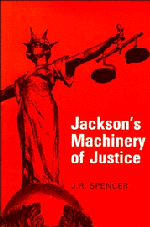Book contents
- Frontmatter
- Contents
- Acknowledgements
- List of figures
- List of tables
- Preface
- Preface to the first edition of ‘The Machinery of Justice in England’
- Abbreviations
- I Historical introduction
- II Civil jurisdiction
- III Tribunals
- IV Criminal jurisdiction
- V The personnel of the law
- VI The European dimension
- VII The cost of the law
- 38 The finances of the law courts
- 39 ‘Costs’
- 40 Legal aid
- 41 Future prospects for legal aid
- VIII Law Reform
- Appendix A The Report of the Civil Justice Review
- Table of Cases cited
- Table of Statutes cited
- Table of Stationery Office publications cited
- Index
38 - The finances of the law courts
Published online by Cambridge University Press: 10 January 2011
- Frontmatter
- Contents
- Acknowledgements
- List of figures
- List of tables
- Preface
- Preface to the first edition of ‘The Machinery of Justice in England’
- Abbreviations
- I Historical introduction
- II Civil jurisdiction
- III Tribunals
- IV Criminal jurisdiction
- V The personnel of the law
- VI The European dimension
- VII The cost of the law
- 38 The finances of the law courts
- 39 ‘Costs’
- 40 Legal aid
- 41 Future prospects for legal aid
- VIII Law Reform
- Appendix A The Report of the Civil Justice Review
- Table of Cases cited
- Table of Statutes cited
- Table of Stationery Office publications cited
- Index
Summary
In the past the growth of royal justice was partly due to the profits that accrued from exercising jurisdiction. The early itinerant justices were more concerned with safeguarding the King's fiscal rights than with the trial of ordinary actions. A law court was expected to show a profit for the King. It is some time since justice has been a substantial source of income, but the old idea survives in the idea that civil courts ought not to be run at a loss.
There is a substantial difference between the finances of civil courts and those of criminal courts. A civil court is a facility provided by the State and those who make use of the courts must pay the equivalent of an entrance fee and further fees for the various stages of the proceedings. Criminal courts are part of the machinery of the State for enforcing law and order and virtually the whole of the cost falls on public funds. The cost of running criminal courts and the cost of prosecutions may usefully be considered together.
The principle was originally that crime was a local matter to be dealt with locally at local cost. Counties had to provide court-houses, lodgings for Assize Judges and the salaries and outgoings required for Assize Courts and County Quarter Sessions.
- Type
- Chapter
- Information
- Jackson's Machinery of Justice , pp. 443 - 448Publisher: Cambridge University PressPrint publication year: 1989

